Recent Articles
Popular Makes
Body Types
2022 GMC Acadia vs. 2022 Ford Explorer
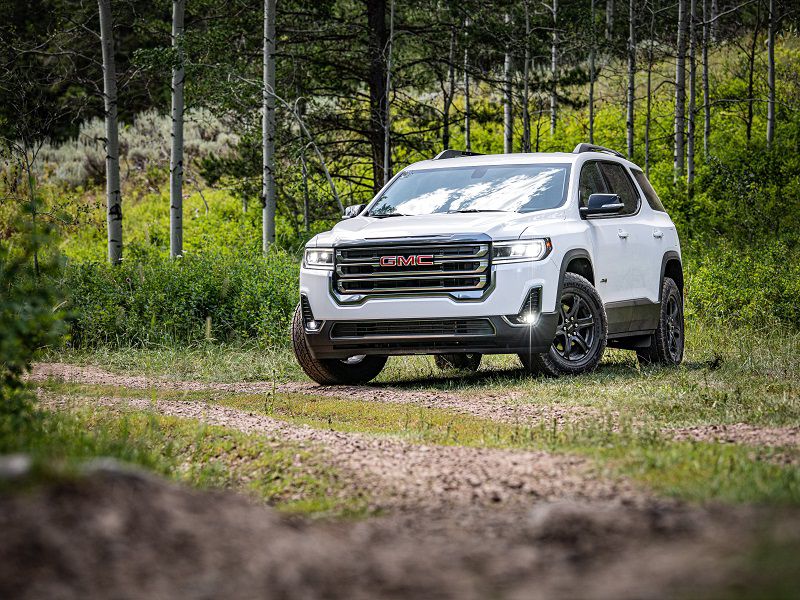
2020 GMC Acadia AT4 ・ Photo by GMC
Both the Ford Explorer and GMC Acadia have been longtime entrants in the mid-size SUV segment, but they have approached the market differently. The Explorer pioneered the 4-door mid-size SUV segment way back in the 1980s, and it has maintained a strong presence ever since. When the vehicle got a complete makeover for the 2020 model year, Ford switched from a front-drive-oriented platform to a rear-drive architecture. The effort was taken to enable the Explorer to continue to compete in important capabilities like towing while maintaining its sharper exterior design. GMC executives have positioned the GMC Acadia differently. Like the Explorer, it offers attractive exterior style, several powertrain choices, and an excellent infotainment system. But in the battle of mid-size family SUVs, it presents a smaller, less accommodating size. It is five inches shorter in overall length than the Ford Explorer. Some might like the handiness and style of the Acadia. Others might be disenchanted with its very tight third row. Here is our comparison of the 2022 Ford Explorer and 2022 GMC Acadia.
Exterior Style
crossover suvs don’t usually set drivers' hearts aflame from an exterior design perspective, but the 2022 Ford Explorer and 2022 GMC Acadia are, to our eyes, two of the best-looking vehicles in the class. The rear-drive architecture gives the Explorer a stance that front-drive-oriented crossovers can’t quite pull off. The Ford uses its extra length to its advantage. Combined with a sleek, laid-back grille, the Explorer looks lithe and muscular. The Acadia counters with a big GMC-style multi-bar grille. Both SUVs feature horizontal headlights, and there are similarities in the designs in profile as well. Both Acadia and Explorer feature a prominent forward-leaning “c-pillar” in front of the most rearward side window. The Explorer’s roof rails telegraph that it’s an SUV. Some versions of the Acadia do without them. In total, while we like the looks of the Acadia, we like the Explorer a bit better.
: Ford Explorer
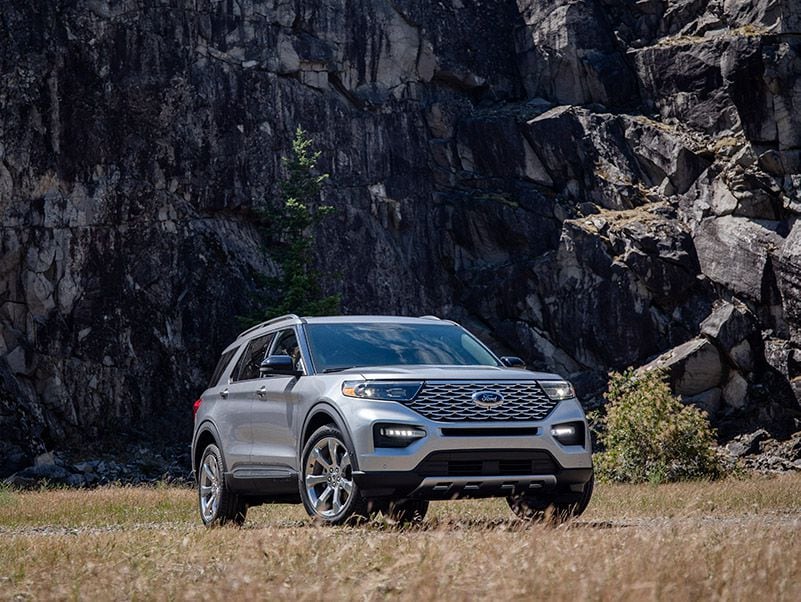
Photo by Ford
Interior Design
Just as with exterior design, the interiors of the Ford Explorer and GMC Acadia have certain similarities. Both interiors are generally well-designed, and the mid-level models kick things up a notch or two with better-quality materials. Both vehicles can transport a family of up to seven, but the third rows in both are not suited to transporting adults. The Explorer’s third row is more accommodating than the Acadia’s, however. When it comes to equipment levels, even the base Explorer has an 8-way power-adjustable driver’s seat, 4-way manually adjustable front passenger seat, 35/30/35 split-fold-flat second-row seats with outboard seat recline, and 50/50 fold-flat third-row seat. In the base Acadia SLE, a power-adjustable driver’s seat is an option, and 6-passenger seating with second-row captain’s chairs and 50-50 split third-row seats is the standard configuration. The more even battle might be at the top-of-the-line where GMC presents the fully loaded Denali trim that faces off against the recently introduced Explorer King Ranch trim.
: Ford Explorer
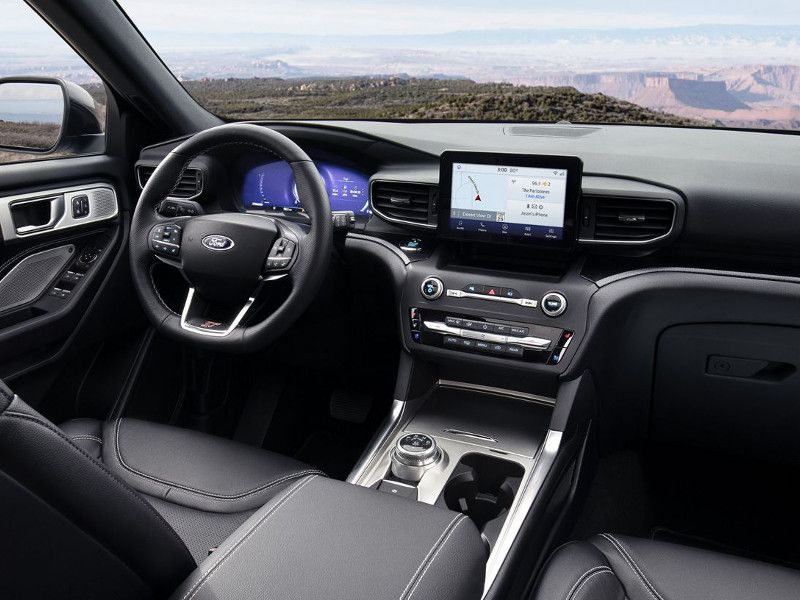
Photo by Ford
Infotainment & Technology
The GMC Acadia and Ford Explorer have robust, easy-to-use infotainment systems. The base Explorer has Ford’s SYNC 3 infotainment system featuring an 8-inch capacitive touchscreen with swipe and pinch-to-zoom capabilities. Apple CarPlay and Android Auto are standard across the Explorer lineup. So is FordPass Connect, which has Wi-Fi hotspot capability. A sound system by Bang & Olufsen with 12 speakers and HD Radio are standard on Limited and higher trim levels, while the standard audio system in most other trims is a 6-speaker unit. A 10.1-inch vertical touchscreen is available in an optional package on top trims. Like the Explorer, the standard touchscreen in the Acadia is an 8-inch unit. It features large icons that are easy to touch while in motion. Wireless Apple CarPlay and wireless Android Auto add to the convenience level. Navigation is standard in SLT, AT4, and Denali trims. A built-in Wi-Fi hotspot enables connectivity for several onboard devices at once. The AT4 and Denali have an abundance of USB ports. An 8-speaker Bose audio system is available as an optional audio choice.
: Ford Explorer
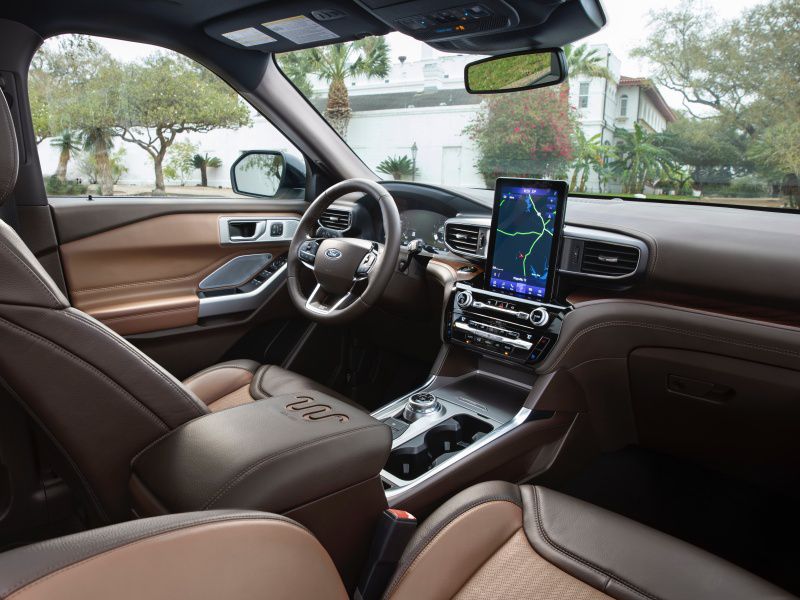
Photo by Ford
Powertrains
The GMC Acadia offers two engine choices after dropping the previous base 4-cylinder engine after last year. For 2022, the base engine is much better — a 258-horsepower 2.0-liter turbocharged 4-cylinder. A 310-horsepower 3.6-liter V6 is offered in top-level trims. The Acadia’s engines are matched to 9-speed automatic transmissions. The engines provide more-than-adequate performance, but none stand out. In comparison, the Explorer offers a broader array of powertrain choices. Base, XLT, and Limited trims are powered by a 2.3-liter EcoBoost 4-cylinder engine that produces 300 horsepower. It drives either the rear wheels or all four wheels through a 10-speed automatic transmission. The Platinum edition Explorer has a 3.0-liter EcoBoost V6 that offers 365 horsepower mated to a 10-speed automatic. All Platinum models are 4-wheel-drive. The Explorer Hybrid has a 3.3-liter V6 supplemented by an electric motor to produce 318 combined horsepower. The Explorer ST offers a 400-horsepower 3.0-liter EcoBoost V6, 10-speed automatic, and 4-wheel-drive.
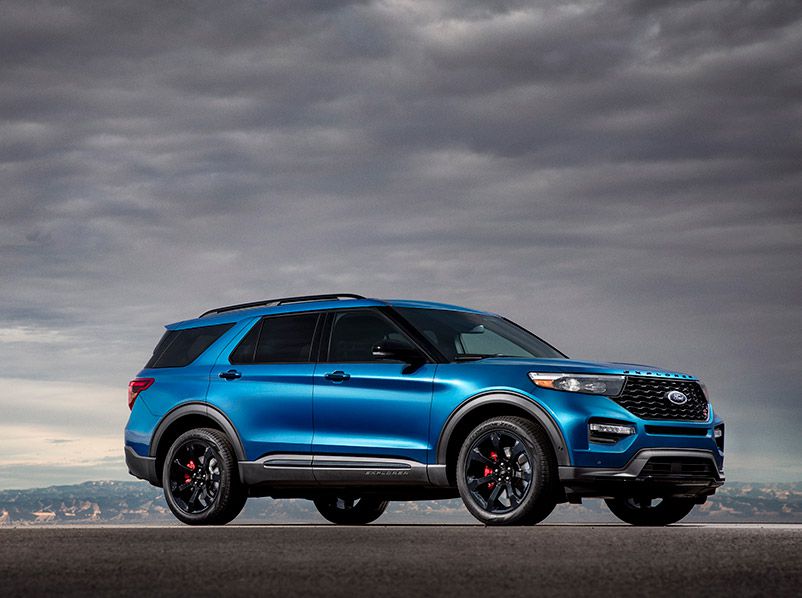
Photo by Ford
Driving Impressions
With the base engine, the GMC Acadia offers good performance and a comfortable, predictable ride. With the more powerful engine, the driving experience becomes more involved, and handling is on par with other crossovers in the segment. The AT4’s torque-vectoring all-wheel-drive improves the vehicle’s off-road performance. In the Explorer, the driving experiences vary from very good to excellent. The 2.3-liter 4-cylinder models offer more-than-adequate power and torque, and the models with the 3.0-liter turbocharged V6s are that much better to drive. Of course, the performance of the 400-horsepower Explorer ST gets attention from those who seek more driving verve. Ford engineers went to special lengths to endow the Explorer Hybrid with the drivability of the other Explorers. Several Explorer models equipped with 4-wheel-drive perform well off-road, including the hybrid. The Acadia AT4 trim is the model’s designated off-roader.
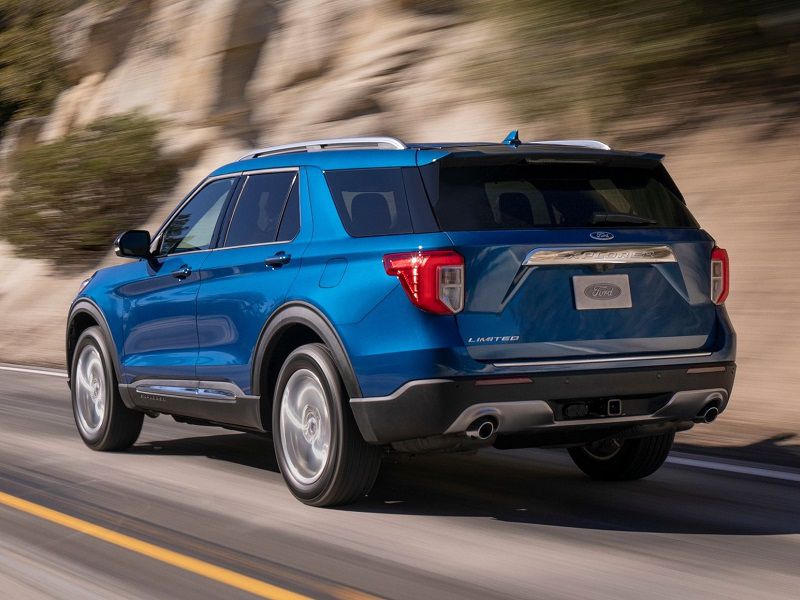
Photo by Ford
Safety & Driver Assists
Both the GMC Acadia and Ford Explorer can be equipped with numerous active safety features. The Explorer offers Ford’s Co-Pilot360 technology. The standard active safety features include automatic high-beam headlights, blind-spot warning system with cross-traffic alert, lane-keeping alert and assist, pre-collision assist with automatic emergency braking and pedestrian detection, and rear-view camera. Explorers also have hill start assist, post-collision braking, reverse-sensing, sidewind stabilization, and trailer sway control. Hill descent control is a feature shared by 4-wheel-drive Explorers, and adaptive cruise control is available on many trims. The 2022 GMC Acadia offers several active safety and driver-assist features. The GMC Pro Safety Plus package is standard. It includes automatic emergency braking, front pedestrian braking, automatic high-beam headlights, front and rear park assist, lane-keeping assist with lane-departure warning, following distance indicator, forward collision alert, lane change alert with blind-spot warning, and rear cross-traffic alert.
: Ford Explorer
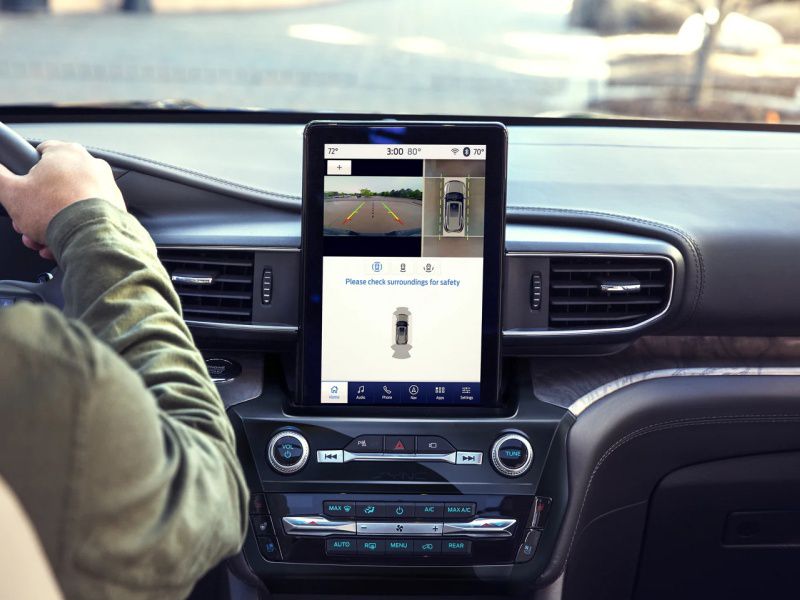
Photo by Ford
Interior & Cargo Space
When it comes to interior space and cargo-carrying comparisons the Ford Explorer is just plain bigger than the GMC Acadia. With the rear rows of seats up for use, the Ford Explorer has 18.2 cubic feet of cargo space, and with the third-row seatbacks folded, the Explorer offers 47.9 cubic feet. With all the rear rows folded, the Explorer has about 87 cubic feet of total cargo area. In comparison, the GMC Acadia offers 12.8 cubic feet behind its third-row seat and 41.7 cubic feet of luggage space behind the second row with the third row folded. With all rear seats folded in the 7-passenger version, the maximum cargo space in the Acadia is 79.0 cubic feet. Those numbers are a long way from the space offered in the Ford Explorer and other competitors like the Chevrolet Traverse. Explorers equipped with the 3.0-liter EcoBoost V-6 can tow up to 5,600 pounds, while 2.3-liter EcoBoost-powered Explorers can tow up to 5,300 pounds. The GMC Acadia has a maximum tow rating of 4,000 pounds with the 3.6-liter engine when properly equipped
: Ford Explorer
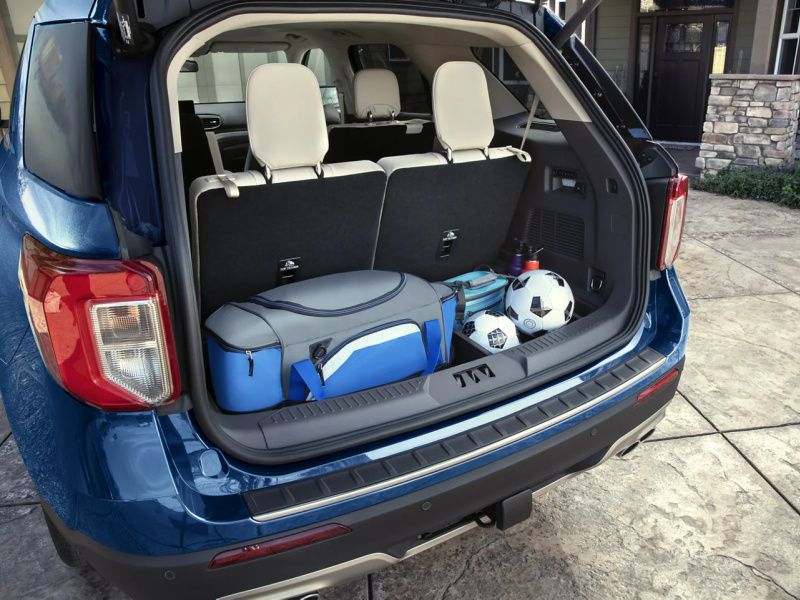
Photo by Ford
Fuel Economy
When it comes to fuel economy numbers, the GMC Acadia narrowly tops the conventionally powered base Ford Explorer, but apples-to-apples comparisons are difficult because of power and size differences. With the 2.0-liter turbocharged engine, the front-drive Acadia has EPA ratings of 22 mpg city/ 29 mpg highway, while the all-wheel-drive version has EPA ratings of 22 mpg city/ 27 mpg highway. The Acadia V6 has an EPA rating of 19 mpg city/ 27 mpg highway in front-drive form and with all-wheel-drive, it is rated at 19 mpg city/ 26 mpg highway. The most fuel-efficient of the Explorers is the hybrid rear-drive version with EPA ratings of 27 mpg city/ 28 mpg highway. A rear-drive Explorer with the base 2.3-liter EcoBoost turbo is rated at 21 mpg city/28 mpg highway. A four-wheel-drive Explorer with the 3.3-liter turbocharged V-6 engine delivers 18 mpg city/ 24 mpg highway.
: Ford Explorer
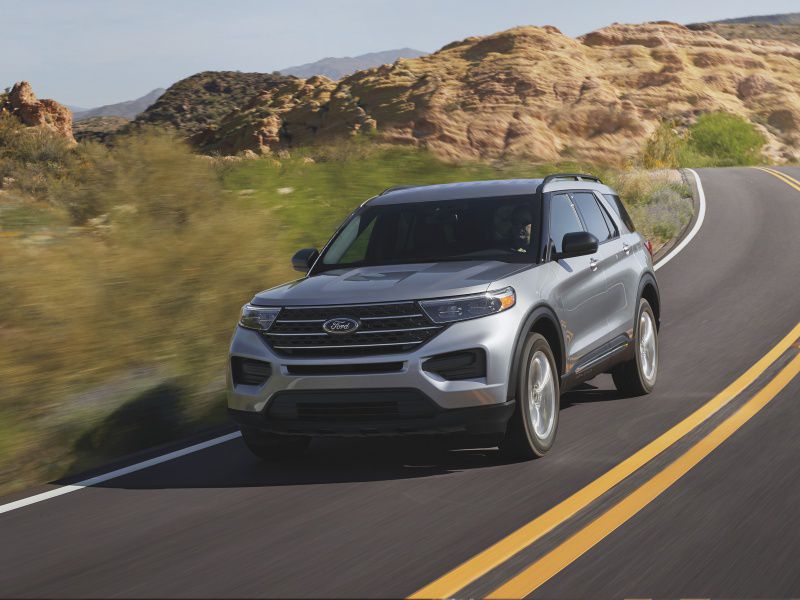
Photo by Ford
Pricing & Value
The 2022 Ford Explorer lineup offers more variety than the more specialized GMC Acadia lineup, but the Acadia does feature the AT4 off-road trim and the Denali luxury trim. The Ford Explorer’s starting price is about $1,500 lower than the Acadia, but both are in the $33,000 to $34,000 range. A mid-level Ford Explorer XLT with 4-wheel-drive has a suggested list price of about $38,000, while the mid-level GMC Acadia SLT with all-wheel-drive lists for over $41,000. The luxurious Explorer King Ranch 4x4 has an MSRP of almost $56,000. The luxurious Acadia Denali has a starting MSRP of around $49,000. The performance-oriented Ford Explorer ST with its 400-horsepower turbocharged V6 has a suggested retail of about $49,000. Good value is to be had in both vehicles, but the Ford Explorer offers much more variety than the GMC Acadia.
: Ford Explorer
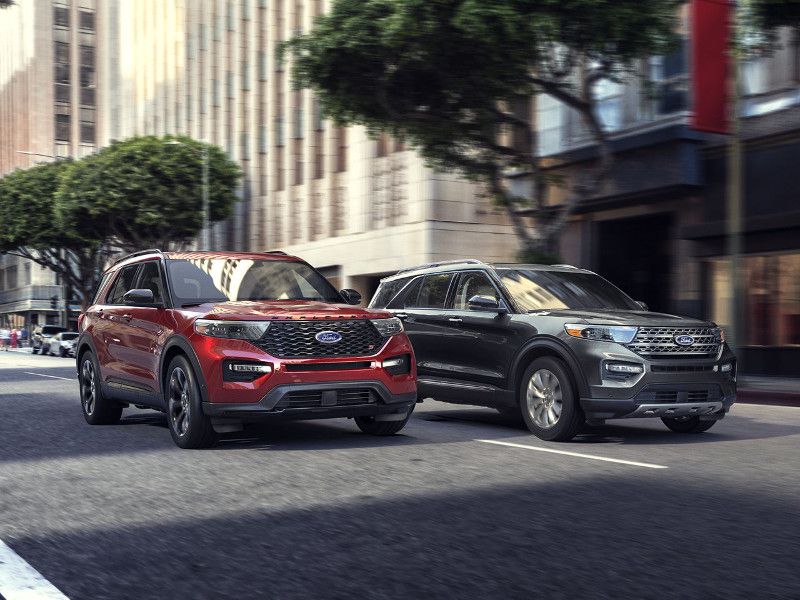
Photo by Ford
The Winner
This comparison is more lopsided than many we’ve seen because these vehicles are aimed at two different buyers. The Ford Explorer has history and sheer sales volume on its side. It’s a mass-market vehicle aimed at a broad cross-section of family buyers. The Explorer offers a more varied lineup, including performance and hybrid models the Acadia lacks. The GMC Acadia is catering to a premium-brand buyer who values the Acadia’s handier size and upscale content. At the same time, in its upper-level trims, the Ford Explorer provides all the luxury the Acadia Denali does... and perhaps a bit more. For the right buyer, the GMC Acadia is a good choice, but in this comparison, the clear winner is the Ford Explorer.
: Ford Explorer
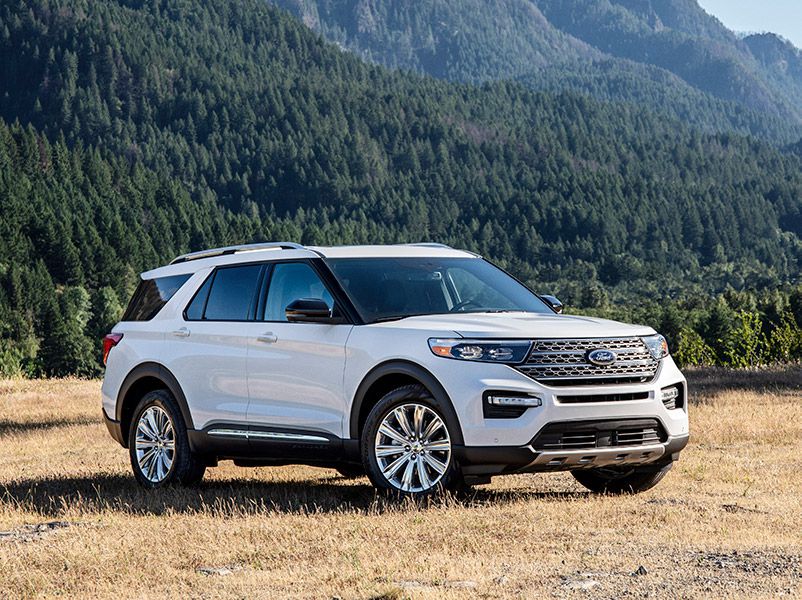
Photo by Ford